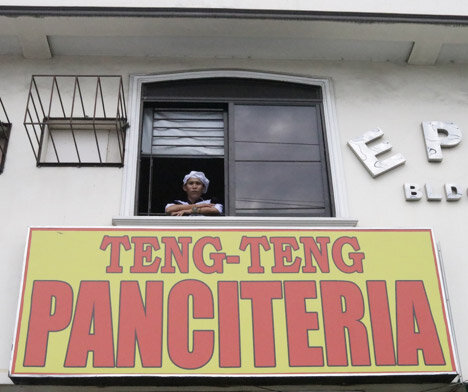Teng-Teng Panciteria
/Teng-Teng Panciteria is named after Chef Teng Rondina (Photo by Mark de la Cruz)
Pancit is immortalized in the children’s book, Cora Cooks Pancit (Lee & Low Books, 2009). Written by Dorina K. Lazo Gilmore, it is illustrated by Kristi Valiant. The book is about a Filipina American, Cora, who never gets to help her mother in the kitchen. When her older sisters and brother are gone, she volunteers to help her mother cook pancit. She soaks the noodles to soften them, helps shred the chicken, and checks when the noodles are cooked. The family enjoys the pancit and applauds Cora as the chef. There is a glossary of Tagalog words, as well as a user-friendly pancit recipe.
To get a taste of authentic pancit, I visited a panciteria, a restaurant specializing in noodles, in Antipolo City. It’s called Teng-Teng Panciteria. Owner Joey Angeles gladly showed me the menu. Although Teng-Teng offers fish-and-vegetable dishes, its specialty is the pancit, with the following variations: pancit-canton – wheat-flour noodles; pancit-miki – made of all-purpose flour, may be flat or round; pancit-bihon – very long, thin noodles made with rice flour; miki-bihon; pancit-lomi – thick fresh egg noodles of about a quarter of an inch in diameter; pancit with lechon (roast pork); pancit with shrimp; pinagulong (wheeled) – dry wheat-flour noodles; and alanganin (perplexed) - dry all-purpose flour, may be flat or round.
Chef Teng Rondina and owner Joey Angeles of Teng-Teng Panciteria (Photo by Mark de la Cruz)
Teng-Teng Panciteria is a popular hole-in-the-wall. The food is not grand, but what matters is the good quality for the price, making customers come back again and again. I asked Angeles how he became a restaurateur. “Out of necessity,” he replied. He loaned money to a friend who was establishing a restaurant. Unfortunately, his friend passed away. Angeles did not know what to do. He could either continue the business, or simply give it up. “I decided to take the risk,” he continued, “and keep operating the restaurant.”
In the beginning, it was very difficult. He had to ask his relatives and household helpers to pitch in. He was groping in the dark as his family was into shoe business and never in restaurants. But he persevered and succeeded! Today, he owns a total of 11 restaurants, including Teng-Teng Panciteria, making him a restaurant magnate, which he is too modest to admit. He has another panciteria and the rest is tapsilogan, that is, a restaurant specializing in tapsilog (tapa/sinangang/itlog) (dried or cured beef, garlic fried rice, and egg).
What is his secret to his success? “Pure hard work,” he answered. His accounting degree from San Beda University helped him tremendously. “It’s not all about money though,” he explained. “People are more important. I make sure my employees are trained and treated well.”
Why the name Teng-Teng Panciteria? When Angeles went to register the name of the restaurant, the names that he wanted had already been taken. Right then and there, he thought of his chef, Teng Rondina. He doubled Teng—and presto!—Teng-Teng Panciteria!
Now, I had to talk to the chef! Teng Rondina is mild mannered. You would never think a restaurant was named after him. A native of Mobo, Masbate, he learned to cook on the job. He spoke of the importance of the hand, for example, in handling the ladle and throwing in the right flavors. Each dish is a challenge, and he finds ways to make dish one better.
On my way to getting more familiar with pancit, I got to meet Cora Cooks Pancit, Joey Angeles, Teng Rondina, and Teng-Teng Panciteria—sending me on a long and passionate relationship with Pinoy noodle dishes! Mabuhay!
The book Cora Cooks Pancit immortalizes the pancit
UPDATE
At the beginning of the pandemic and lockdown, Teng-Teng Panciteria was closed for two months. Now, it is fully open, and business has been picking up.
Joey Angeles’ other restaurants are also operating. However, the tapsilogan has limited hours because of curfews. “Most of our diners are in the evening and early morning,” he told me, “and we don’t have that crowd anymore.”
He is not complaining. On the contrary, he feels blessed that he can open his restaurants, keep his employees, and make his customers have a great dining experience.
Teng-Teng Panciteria
EPC Building
B. Soliven Avenue
Barangay Mayamot
Antipolo City, Philippines
Video follows*
Book Read Aloud: Cora Cooks Pancit:
To sample a dish from Teng-teng Panciteria: https://www.positivelyfilipino.com/magazine/the-happy-home-cook-pork-ampalaya-bittermelon
Rey E. de la Cruz, Ed.D., Positively Filipino correspondent, writes from Chicagoland when he is not loving the arts and traveling in seven continents. He is the author of the children’s book, Ballesteros on My Mind: My Hometown in the Philippines, which also has Ilocano, Spanish, and Tagalog editions, seven songs, and a film. His baby book and fourth-grade Tagalog diary are in the collection of The Newberry, an independent research library for the humanities in Chicago.
More articles from Rey E. de la Cruz






